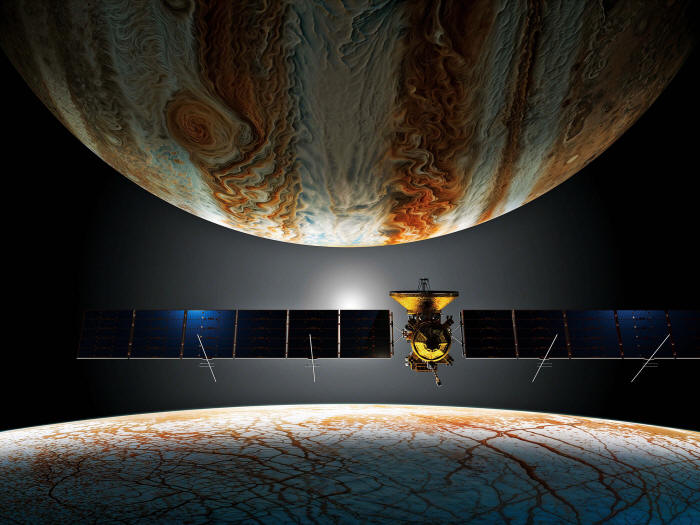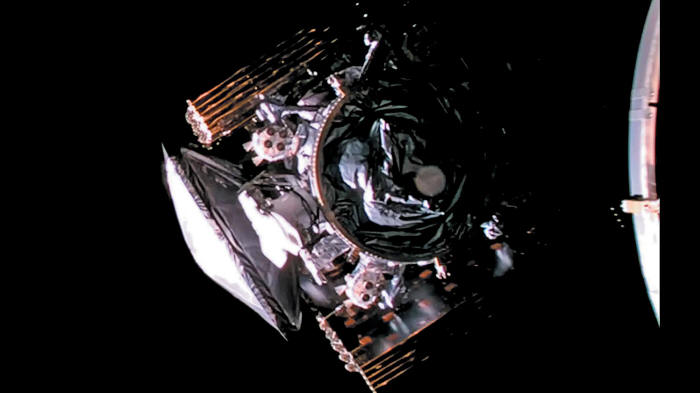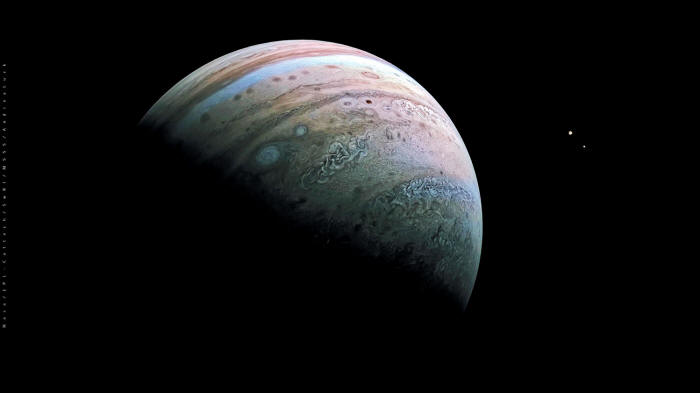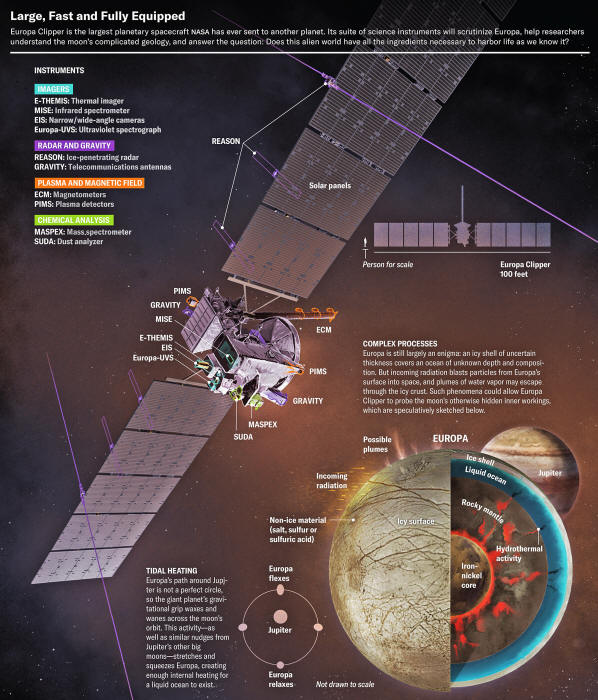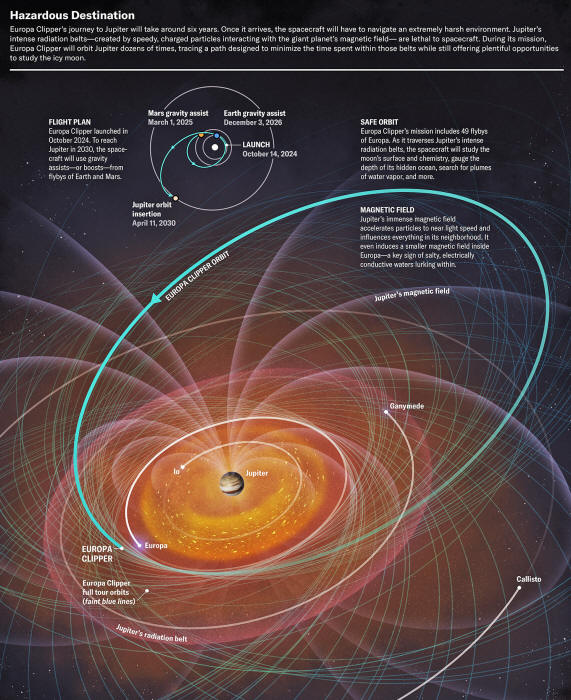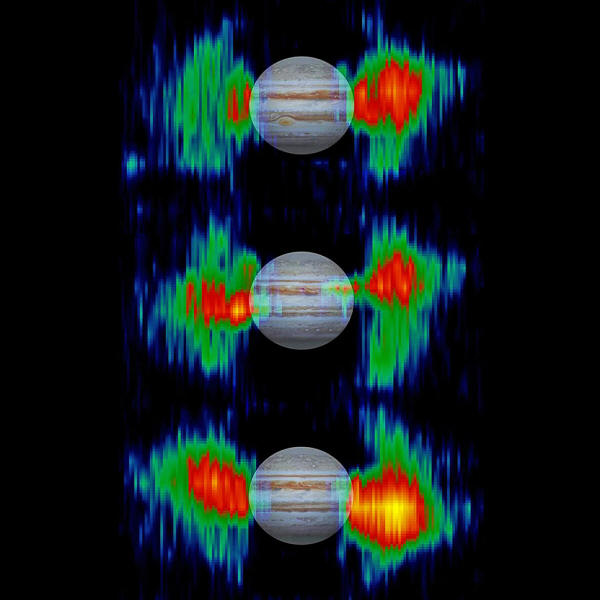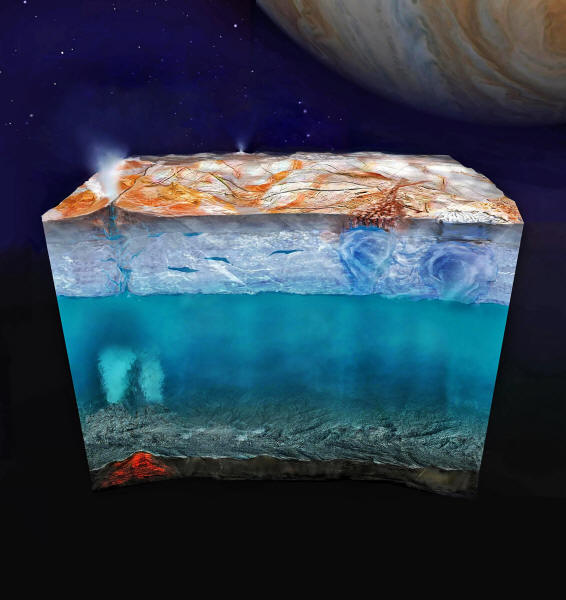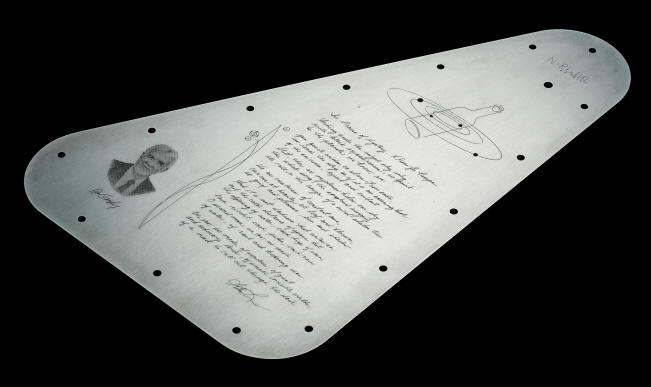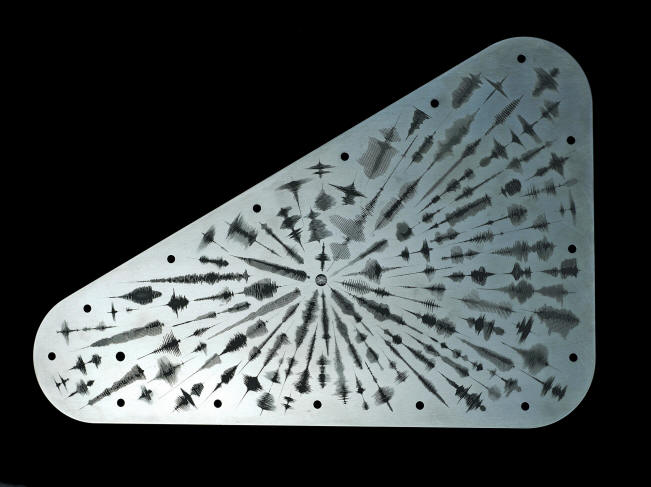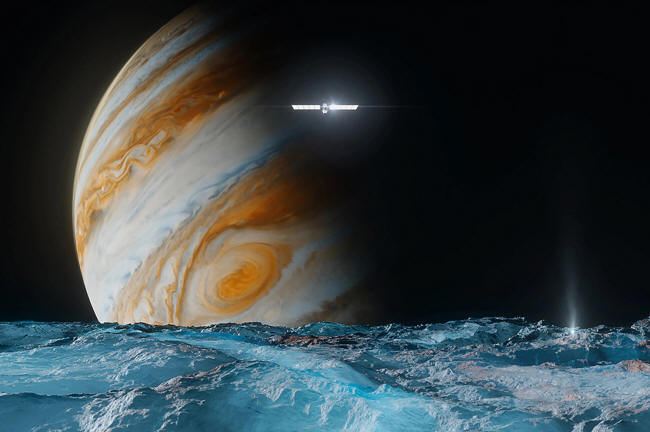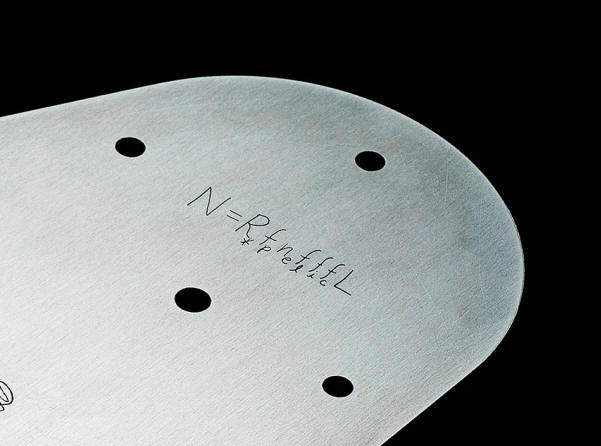|
by Nadia Drake
Mondolithic
Studios we are sending a spacecraft to explore an alien ocean world, a moon that might host life today...
Loosed from our world's gravitational harbor by SpaceX's fire-breathing Falcon Heavy rocket, NASA's Europa Clipper spacecraft is now sailing toward the Jupiter system.
Its target:
Europa's interior may be home to a moon-spanning, briny sea that could possess all the elements needed to craft and cradle life as we know it: energy, chemistry and water.
And Europa's hidden ocean is thought to hold more water than all of Earth's oceans combined.
For decades, this moon has charmed alien-hunting space scientists. But sending spacecraft to scout extraterrestrial seas is neither trivial nor for the impatient.
Voyages to the outer solar system can take so long to realize that many scientists who embark on these projects know they may not be around to see the mission's end.
Long, sinuous fissures and ridges crisscross Europa in this color composite view from NASA's Galileo probe, hinting at deeper geological activity
that has cracked and
jumbled the icy moon's surface.
Clipper's launch, which came after more than 20 years of painstaking preparations, is just the first step in the second half of the spacecraft's $5.2-billion story.
Its journey to the outer solar system, hastened by a spiral trajectory that takes advantage of gravitational nudges from both Earth and Mars, will cover 1.8 billion miles and take around six years to complete.
Once it pulls into port at Jupiter in 2030, the spacecraft will loop around the giant, storm-wracked planet, charting a course that will carry it by Europa 49 times over four years.
Lit only by faint shards of sunbeams, Jupiter and the rest of the outer solar system's worlds are realms of mystery. But the Clipper mission signifies a dawning era in which this region's subsurface seas will snap into sharper focus.
Scientists are now turning their gaze not only to Europa but to other ocean-bearing icy moons such as Saturn's Titan and Enceladus - each of which could be habitable (and inhabited) today.
A camera on the spacecraft's rocket booster (right) offered one last look at NASA's Europa Clipper (left)
before the probe
departed on its multiyear interplanetary journey.
If our solar system is any guide, such small, icy satellites greatly outnumber planets, and they could transform our ideas about where life might thrive.
Clipper's goal is to learn whether Europa really is a habitable world - to confirm that, as most every space scientist is already convinced, an ocean is truly tucked away underneath the moon's crust, where it has perhaps brewed biology's raw ingredients for billions of years.
The mission's personnel suspect they'll find a life-friendly sea, but until the spacecraft arrives and does the work, no one knows for sure.
With its nine onboard instruments, Clipper will also study Europa's otherworldly chemistry, make detailed maps of the moon's icy, chaotic surface, search for enigmatic plumes of water vapor wafting into space and use ice-penetrating radar to look for lakes within the frozen rind.
That is, if its hardened electronics - shown in a late-breaking curveball to be more vulnerable than expected to Jupiter's spacecraft-frying radiation - can survive the onslaught that awaits.
Turtle is also leading the Dragonfly mission to explore Titan, slated to launch in 2028 at the earliest.
Extraterrestrial Seashores
In 1609 Europa was but a twinkle in Galileo Galilei's eye when he aimed a homemade telescope at Jupiter and spotted several smaller dots of light.
After plotting their motions, Galileo correctly surmised that the quartet were not distant background stars but Jupiter's most noteworthy lunar companions.
Now, four centuries later, Europa, Io, Ganymede and Callisto - known as the Galilean moons - are challenging stale conceptions about where clement, life-friendly conditions can exist.
For a time,
Europa (rightmost orb, next to neighboring moon Io) is scarcely noticeable in this Jupiter-dominated image from NASA's Juno spacecraft, but its importance
for future
exploration of the outer solar system is enormous. Andrea Luck (image processing) © CC BY
But in 1979 NASA's twin Voyager spacecraft swept by Jupiter and revealed "strange new 'worlds' of fire and ice" - ongoing volcanic eruptions on Io, terrains on Ganymede that turned out to vary in age by billions of years, a curiously youthful icy crust on Europa - and strange clues that, perhaps, something sloshed below.
Then, in 1995, NASA's,
And the fuzzy hint of a watery interior?
That sharpened into almost indisputable evidence for a buried, global, saltwater sea - albeit one of unknown depth - held within a frosty shell of unknown thickness.
Now, based on those observations and studies of Saturn's oceanic moons, it seems that a world's biological potential does not depend solely on its distance from its sun - and maybe not even on sunlight at all, if the lessons we're learning about life around hydrothermal vents and our planet's other dark nooks are applicable to alien worlds as well.
Matthew Twombly
Matthew Twombly
Building on years of advocacy from planetary scientists, in 2011 a high-level expert committee that defines NASA's science priorities recommended focusing on a large-scale mission to study Europa and its ocean, labeling the moon as,
Until then, the bulk of NASA's astrobiology funding had focused on Mars - a world that is almost certainly sterile today (at least on the surface) but that may have hosted life some three billion to four billion years ago in its warmer, wetter past.
Finding room for other worlds within the relentless drumbeat for Mars, a planet right next door, had proved challenging.
But the 2011 directive infused momentum into a project that had been quietly coalescing for years:
With the help of planetary science advocacy groups and a crucial assist from former Congressman John Culberson of Texas - himself a Europa aficionado, well versed in the scientific literature and passionate about finding alien life - the mission that eventually became Europa Clipper got the green light from NASA in 2015.
Then the team began designing the spacecraft, plotting its trajectory and building the instruments.
Culberson was there when Clipper launched on October 14, alongside NASA leadership on a balcony at Kennedy Space Center.
He used large image-stabilizing binoculars to watch the spacecraft's ascent.
Three views of Jupiter's sprawling and deadly inner radiation belts, based on data from NASA's Cassini spacecraft. Each view comes from a different point in the giant planet's 10-hour rotation, revealing how the seething, spacecraft-frying emissions
change over time.
The final mission that launched isn't much like early concepts.
But Europa Clipper is the largest spacecraft yet built for interplanetary exploration:
It carries world-class cameras, a magnetometer, a surface dust analyzer, and the most capable mass spectrometer - which ingests molecules to determine their composition and origin - ever flown.
It's also a mission that, despite many fateful escapes from near-death experiences during its long incubation, almost succumbed to a potentially fatal last-minute plot twist.
A Lethal Challenge
In 1959, two years before he came up with his eponymous framework for estimating the prevalence of life in the cosmos, astronomer Frank Drake aimed a radio telescope at Jupiter and detected the unmistakable signature of high-speed electrons tracing twisted pathways along magnetic field lines.
Called synchrotron radiation, the signature exists because Jupiter's magnetic field is strong enough to accelerate charged particles to near light speed.
The implication of Drake's observation was undeniable:
Every spacecraft destined to explore the Jupiter system is specially designed to endure (at least for a time) those lethal belts.
Europa Clipper was no different, as its lunar destination boasts an intense radiation environment.
But at a meeting in May 2024, shortly before Clipper was scheduled to ship to Florida, NASA engineers learned that some of the radiation-hardened circuits onboard the spacecraft were unexpectedly vulnerable.
The information came from another government agency that had purchased the same parts from the same German supplier.
Called metal oxide semiconductor field-effect transistors, or MOSFETs, the weakened parts are transistors that basically act as toggle switches.
And this batch of MOSFETs degraded under lower radiation doses than promised - doses so low, in fact, that it was questionable whether Clipper could survive long enough to deliver the observations the team had dreamed of for decades.
Within a day of learning about the problem, a team got to work on it.
The transistors were distributed across the spacecraft and integrated into each instrument system; they were also in the now sealed electronics vault, a specially shielded compartment that is like the nerve center of the entire operation.
The mission was in peril.
And there was no time to delay:
Betting on success, JPL sent Clipper to the Kennedy Space Center anyway.
And over the summer, worried scientists and engineers worked days, nights and weekends to devise a solution to a vexing problem they hadn't even created.
By the end of August they had a fix...
What lies beneath Europa's frosty exterior? This not-to-scale artist's concept shows one possibility: a deep, global saltwater ocean, surmounted by a sizable crust of ice and with an underlying rocky core. Energy and nutrients may well up from below via hydrothermal vents on the seafloor or could trickle down from above via convective processes within the crust. Plumes of material may vent from the surface into space, sourced either directly from the ocean
or from liquid-water
reservoirs trapped within the crust.
Rather than replacing each faulty part or modifying the observation plans, the spacecraft would fly as planned.
It would follow its charted sequence of 21-day orbits around Jupiter, circling the giant planet 80 times. At most, it would spend one day during each orbit within the radiation belts.
For the rest of the time, when Clipper was outside the harshest radiation, the team could turn on some of the spacecraft's heaters and warm the weakened circuits, in hopes of repairing some of the radiation damage through a process called annealing - essentially a thermally induced salve that redistributes charged particles to preserve the switch's integrity.
It seemed like a miracle solution and almost too good to be true, given its forecasted minimal impacts on Clipper's science.
Understanding an Ocean World
As Clipper swoops by Europa, its nine science instruments will be trained on the moon, seeking to understand how it all works.
An interactive 3D view of Europa Clipper's vault plate. Spin the digital model to see the plate's compendium of Earth languages, a poem for Europa, a version of the iconic Drake equation and more. NASA/JPL-Caltech
In other words, if the clarion call of Europa is nothing but a siren song,
(No one expects that will be the case, although as all good, cautious scientists do, they'll wait to see the evidence.)
NASA/JPL-Caltech
Back (top) and front (bottom) views are shown of Europa Clipper's vault plate, which is engraved with poetry, illustrations,
and other messages
from Earth.
As the spacecraft flies, it will also look for any signs of Europa's plumes - tentative puffs of water vapor first described in 2013 that would be smaller, more subtle versions of the energetic geysers erupting from Saturn's moon Enceladus.
According to the mission's lore, those plumes are part of the glue that sealed the deal on Clipper; if the spacecraft got lucky, it could fly through a plume and directly sample the stuff of Europa.
And although NASA is not billing Clipper as a life-detection mission, flying through a plume could prove otherwise - but sniffing out signs of life hinges on several unlikely events.
Messages in a Bottle
Clipper will, if nothing else, provide some ground truthing for the idea that when it comes to the rules of life, a world's distance from its star is far from the only thing that matters.
And understanding the fundamentals of habitability is crucial for filling in the values of the Drake equation - a framework, devised by the same astronomer who inferred the presence of Jupiter's radiation belts, that has guided the search for life beyond Earth since the early 1960s.
These questions, Pappalardo says,
In the grandest sense, Drake's fingerprints - and his willingness to unabashedly ask big questions about alien life - are all over Clipper's mission.
He relished the chance to observe Jupiter and its moons until he was in his 90s, often gazing at the planet as it rose above the beloved redwood trees that ringed his home in the hills outside Santa Cruz, Calif.
But Drake (better known to me as Dad) didn't live to see Europa Clipper launch.
He died in 2022. In the 60 years since Dad wrote the formula we now use to confront our apparent cosmic solitude, the field of astrobiology has emerged and matured.
Clipper's lead scientists, many of whom started their careers in the 1970s or 1980s as graduate students or postdocs on Voyager or Galileo, are now at the helm.
And the next generation of leading planetary scientists, many of whom weren't even born when we lobbed our first probes toward the outer solar system, are now working on Clipper.
An artist's concept of NASA's Europa Clipper spacecraft swooping over Jupiter's icy ocean-bearing moon Europa,
a hot spot in
humanity's epochal search for alien life.
Time, it seems, is the resource that exploring the outer solar system most requires.
Every Clipper team member knows this mission could be their fleeting, once-in-a-lifetime chance to get a close look at Europa.
Because when it comes to the outer solar system, as a scientist,
And so, the Clipper team decided to commemorate this first voyage from one ocean world to another.
Sealing the spacecraft's vault - its nerve center - is a plate forged from tantalum metal.
Unlike other messages we've sent into the stars, Clipper's tidings will go only as far as the Jupiter system.
When the spacecraft bearing our dreams and inscriptions ends its mission, it will crash into Ganymede, where any hitchhiking Earthly microbes are unlikely to contaminate that moon's lifeless surface.
There the vault plate and its records of humanity will end with the mission - in a kind of bittersweet finale that will keep Europa, with its promise of extraterrestrial life, safe for future generations to explore.
|


